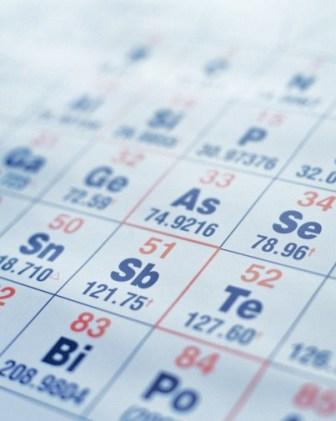
In its Critical Materials Strategy, the U.S. Department of Energy (DOE) focused on materials used in four clean energy technologies:
• Wind turbines – permanent magnets.
• Electric vehicles – permanent magnets & advanced batteries.
• Solar cells – thin film semi conductors.
• Energy efficient lighting – phosphors.
The DOE says they selected these particular components for two reasons. The deployment of the clean energy technologies that use them is projected to increase, perhaps significantly, in the short, medium and long term; and that each uses significant quantities of rare earth metals or other key materials.
In its report the DOE provided data for nine rare earth elements and indium, gallium, tellurium, cobalt and lithium. Five of the rare earth metals – dysprosium, neodymium, terbium, europium and yttrium – as well as indium, were assessed as most critical in the short term. The DOE defines “criticality” as a measure that combines importance to the clean energy economy and risk of supply disruption.
In another report by the APS Panel on Public Affairs and the Materials Research Society a second term was coined, “energy-critical element” (ECE), to describe a class of chemical elements that currently appear critical to one or more new, energy related technologies.
“Energy-related systems are typically materials intensive. As new technologies are widely deployed, significant quantities of the elements required to manufacture them will be needed. However, many of these unfamiliar elements are not presently mined, refined, or traded in large quantities, and, as a result, their availability might be constrained by many complex factors. A shortage of these energy-critical elements (ECEs) could significantly inhibit the adoption of otherwise game-changing energy technologies. This, in turn, would limit the competitiveness of U.S. industries and the domestic scientific enterprise and, eventually, diminish the quality of life in the United States.”
According to the APS report several factors can contribute to limiting the domestic availability of an ECE:
• The element may not be abundant in the earth’s crust or might not be concentrated by geological processes.
• An element might only occur in a few economic deposits worldwide, production might be dominated by and, therefore, subject to manipulation by one or more countries – the United States already relies on other countries for more than 90% of most of the ECEs identified in the report.
• Many ECEs have, up to this point, been produced in relatively small quantities as by-products of primary metals mining and refining. Joint production complicates attempts to ramp up output by a large factor.
• Because they are relatively scarce, extraction of ECEs often involves processing large amounts of material, sometimes in ways that do unacceptable environmental damage.
• The time required for production and utilization to adapt to fluctuations in price and availability of ECEs is long, making planning and investment difficult.
This report was limited to elements that have the potential for major impact on energy systems and for which a significantly increased demand might strain supply, causing price increases or unavailability, thereby discouraging the use of some new technologies.
• Gallium, germanium, indium, selenium, silver, and tellurium – employed in advanced photovoltaic solar cells, especially thin film photovoltaics.
• Dysprosium, neodymium, praseodymium, samarium and cobalt – used in high-strength permanent magnets for many energy related applications, such as wind turbines and hybrid automobiles.
• Gadolinium (most REEs made this list) for its unusual paramagnetic qualities and europium and terbium for their role in managing the color of fluorescent lighting. Yttrium, another REE, is an important ingredient in energy-efficient solid-state lighting.
• Lithium and lanthanum, used in high performance batteries.
• Helium, required in cryogenics, energy research, advanced nuclear reactor designs, and manufacturing in the energy sector.
• Platinum, palladium, and other PGEs, used as catalysts in fuel cells that may find wide applications in transportation. Cerium, a REE, is also used as an auto-emissions catalyst.
• Rhenium, used in high performance alloys for advanced turbines.
A third report entitled, “Critical Raw Materials for the EU” listed 14 raw materials which are deemed critical to the European Union. Specifically, antimony, beryllium, cobalt, fluorspar, gallium, germanium, graphite, indium, magnesium, niobium, platinum group metals, rare earths, tantalum and tungsten.
“Raw materials are an essential part of both high tech products and every-day consumer products, such as mobile phones, thin layer photovoltaics, Lithium-ion batteries, fibre optic cable, synthetic fuels, among others. But their availability is increasingly under pressure according to a report published today by an expert group chaired by the European Commission. In this first ever overview on the state of access to raw materials in the EU, the experts label a selection of 14 raw materials as “critical” out of 41 minerals and metals analyzed. The growing demand for raw materials is driven by the growth of developing economies and new emerging technologies.”
For the critical raw materials, their high supply risk is mainly due to the fact that a high share of the worldwide production mainly comes from a handful of countries including China (Rare Earth Elements), Russia & South Africa (Platinum Group Elements) and the Democratic Republic of Congo (Cobalt).
Providing a comparative analysis of all three reports one will find that only four critical materials appear on each list. These are rare earth elements (REE), cobalt, platinum group elements (PGE), and lithium.
And the key common issues in regards to what defines “critical materials” are:
• Finite resources.
• Chinese market dominance in many sectors.
• Long lead times for mine development.
• Resource nationalism/country risk.
• High project development cost.
• Relentless demand for high tech consumer products.
• Ongoing material use research.
• Low substitutability.
• Environmental crackdowns.
• Low recycling rates.
• Lack of intellectual knowledge and operational expertise in the west.




 Follow us on Twitter
Follow us on Twitter Become our facebook fan
Become our facebook fan











Comments are closed.